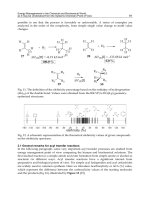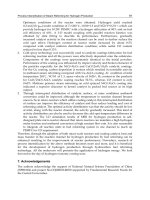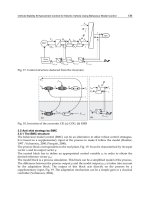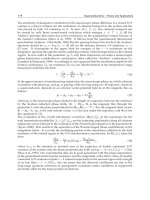Chapter 012. Pain: Pathophysiology and Management (Part 6) pptx
Bạn đang xem bản rút gọn của tài liệu. Xem và tải ngay bản đầy đủ của tài liệu tại đây (62.71 KB, 6 trang )
Chapter 012. Pain:
Pathophysiology and Management
(Part 6)
a
Antidepressants, anticonvulsants, and antiarrhythmics have not been
approved by the U.S. Food and Drug Administration (FDA) for the treatment of
pain.
b
Gabapentin in doses up to 1800 mg/d is FDA approved for postherpetic
neuralgia.Note: 5-HT, serotonin; NE, norepinephrine.Since they are effective for
these common types of pain and are available without prescription, COX
inhibitors are by far the most commonly used analgesics. They are absorbed well
from the gastrointestinal tract and, with occasional use, have only minimal side
effects. With chronic use, gastric irritation is a common side effect of aspirin and
NSAIDs and is the problem that most frequently limits the dose that can be given.
Gastric irritation is most severe with aspirin, which may cause erosion and
ulceration of the gastric mucosa leading to bleeding or perforation. Because
aspirin irreversibly acetylates platelets and thereby interferes with coagulation of
the blood, gastrointestinal bleeding is a particular risk. Increased age and history
of gastrointestinal disease increase the risks of aspirin and NSAIDs. In addition to
NSAIDs' well-known gastrointestinal toxicity, nephrotoxicity is a significant
problem for patients using them on a chronic basis, and patients at risk for renal
insufficiency should be monitored closely. NSAIDs also cause an increase in
blood pressure in a significant number of individuals. Long-term treatment with
NSAIDs requires regular blood pressure monitoring and treatment if necessary.
Although toxic to the liver when taken in a high dose, acetaminophen rarely
produces gastric irritation and does not interfere with platelet function.The
introduction of a parenteral form of NSAID, ketorolac, extends the usefulness of
this class of compounds in the management of acute severe pain. Ketorolac is
sufficiently potent and rapid in onset to supplant opioids for many patients with
acute severe headache and musculoskeletal pain.There are two major classes of
COX: COX-1 is constitutively expressed, and COX-2 is induced in the
inflammatory state. COX-2–selective drugs have moderate analgesic potency and
produce less gastric irritation than the nonselective COX inhibitors. It is not yet
clear whether the use of COX-2–selective drugs is associated with a lower risk of
nephrotoxicity compared to nonselective NSAIDs. On the other hand, COX-2–
selective drugs offer a significant benefit in the management of acute
postoperative pain because they do not affect blood coagulation. This is a situation
in which the nonselective COX inhibitors would be contraindicated because they
impair platelet-mediated blood clotting and are thus associated with increased
bleeding at the operative site. COX-2 inhibitors, including celecoxib (Celebrex),
and valdecoxib (Bextra), are associated with increased cardiovascular risk. It is
possible that this is a class effect of NSAIDs, excluding aspirin. These drugs are
contraindicated in patients in the immediate period after coronary artery bypass
surgery and should be used with caution in patients having a history of or
significant risk factors for cardiovascular disease.
Opioid Analgesics
Opioids are the most potent pain-relieving drugs currently available.
Furthermore, of all analgesics, they have the broadest range of efficacy, providing
the most reliable and effective method for rapid pain relief. Although side effects
are common, they are usually not serious except for respiratory depression and can
be reversed rapidly with the narcotic antagonist naloxone. The physician should
not hesitate to use opioid analgesics in patients with acute severe pain. Table 12-1
lists the most commonly used opioid analgesics.Opioids produce analgesia by
actions in the central nervous system. They activate pain-inhibitory neurons and
directly inhibit pain-transmission neurons. Most of the commercially available
opioid analgesics act at the same opioid receptor (µ-receptor), differing mainly in
potency, speed of onset, duration of action, and optimal route of administration.
Although the dose-related side effects (sedation, respiratory depression, pruritus,
constipation) are similar among the different opioids, some side effects are due to
accumulation of nonopioid metabolites that are unique to individual drugs. One
striking example of this is normeperidine, a metabolite of meperidine.
Normeperidine produces hyperexcitability and seizures that are not reversible with
naloxone. Normeperidine accumulation is increased in patients with renal failure.
The most rapid relief with opioids is obtained by intravenous
administration; relief with oral administration is significantly slower. Common
side effects include nausea, vomiting, constipation, and sedation. The most serious
side effect is respiratory depression. Patients with any form of respiratory
compromise must be kept under close observation following opioid
administration; an oxygen saturation monitor may be useful. The opioid antagonist
naloxone should be readily available. Opioid effects are dose-related, and there is
great variability among patients in the doses that relieve pain and produce side
effects. Because of this, initiation of therapy requires titration to optimal dose and
interval. The most important principle is to provide adequate pain relief. This
requires determining whether the drug has adequately relieved the pain and the
duration of the relief. The most common error made by physicians in managing
severe pain with opioids is to prescribe an inadequate dose. Since many patients
are reluctant to complain, this practice leads to needless suffering. In the absence
of sedation at the expected time of peak effect, a physician should not hesitate to
repeat the initial dose to achieve satisfactory pain relief.An innovative approach to
the problem of achieving adequate pain relief is the use of patient-controlled
analgesia (PCA). PCA requires a device that can deliver a baseline continuous
dose of an opioid drug, as well as preprogrammed additional doses whenever the
patient pushes a button. The patient can then titrate the dose to the optimal level.
This approach is used most extensively for the management of postoperative pain,
but there is no reason why it should not be used for any hospitalized patient with
persistent severe pain. PCA is also used for short-term home care of patients with
intractable pain, such as that caused by metastatic cancer.
Because of patient variability in analgesia requirement, intravenous PCA is
generally begun after the patient's pain has been controlled. The bolus dose of the
drug (typically 1 mg morphine or 40 µg fentanyl) can then be delivered repeatedly
as needed. To prevent overdosing, PCA devices are programmed with a lockout
period after each demand dose is delivered (5–10 min) and a limit on the total dose
delivered per hour. While some have advocated the use of a simultaneous
background infusion of the PCA drug, this increases the risk of respiratory
depression and has not been shown to increase the overall efficacy of the
technique.
Many physicians, nurses, and patients have a certain trepidation about using
opioids that is based on an exaggerated fear of addiction. In fact, there is a
vanishingly small chance of patients becoming addicted to narcotics as a result of
their appropriate medical use.The availability of new routes of administration has
extended the usefulness of opioid analgesics. Most important is the availability of
spinal administration. Opioids can be infused through a spinal catheter placed
either intrathecally or epidurally. By applying opioids directly to the spinal cord,
regional analgesia can be obtained using a relatively low total dose. In this way,
such side effects as sedation, nausea, and respiratory depression can be minimized.
This approach has been used extensively in obstetric procedures and for lower-
body postoperative pain. Opioids can also be given intranasally (butorphanol),
rectally, and transdermally (fentanyl), thus avoiding the discomfort of frequent
injections in patients who cannot be given oral medication. The fentanyl
transdermal patch has the advantage of providing fairly steady plasma levels,
which maximizes patient comfort.









